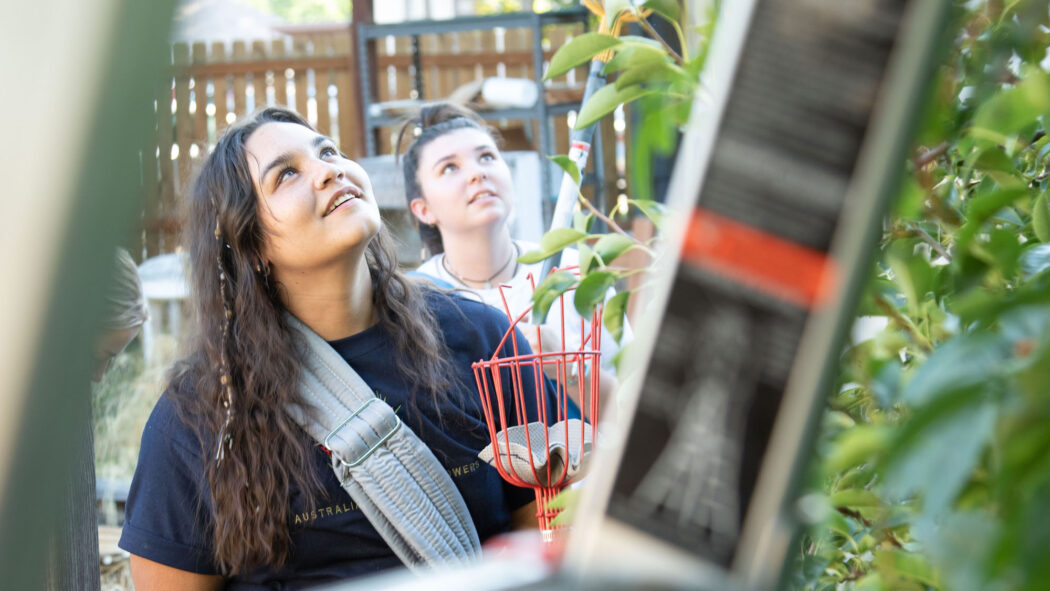Local gleaning team picking away at food issues one pear at a time
The Cache Valley Gleaning Program, founded by former Utah State University Student and Student Nutrition Access Center Food Security Program Coordinator Kara Bachman, in 2019, works to reduce food waste and help prevent food insecurity.
The main way the gleaning team works to do this is by harvesting fruit and vegetables and donating them to local food pantries and nutrition centers like SNAC and Cache Community Food Pantry.
The harvesting season runs from July to October and the gleaning team spends an average of six hours a week picking the fruits and vegetables — two hour sessions three times a week.
And with all this work, the team is always in need of some help. The gleaning program on average has five to eight volunteers per session, but always hope to have closer to 10.
The volunteers are expected to help pick the fruits and vegetables, sort them and prepare them to be donated.
One volunteer, Donell Hales, has been volunteering for a month and a half and explained that although volunteering has its perks, like getting to take home free fruit, the best part is seeing the positive impact on other students.
“It’s so fun to hear when students are going to SNAC and getting fruit and they taste it and they love it,” Hales said. “I think it’s an awesome way to feel part of a community and help the community.”
Though there is no doubt to the gleaning team that they are helping the community, USU student and Cache Community Gleaning Program coordinator, Kate Markman, said that it can be hard to set goals because they can’t control how the fruit or vegetables will turn out.
“Obviously we have goals. But having set amounts of poundage is difficult because it depends on the harvest season,” Markman said. “We have to be flexible, but a goal of mine this season has been to just gain more awareness.”
Markman explained 40% of all food is wasted in the U.S. And although she didn’t have specific local statistics, she said based on her experience, that number probably looks close to the same for Cache Valley.
The USDA gleaning toolkit shared, “Each year, well over 100 billion pounds of food are thrown away in this country.”
To put that a little more into perspective, during one of their 45-minute pear-picking sessions on Aug. 30, the gleaning team collected 112 lbs. of good fruit.
To determine what fruit is good or bad, the volunteers evaluate it by grades. Grade A, means that it is in a condition you would expect to find at a grocery store. Grade B, means that it’s still good fruit but needs some cleaning up from cracks or maybe even bugs. If it’s worse than grade B, then it’s no good.
Grade B fruit is what gets donated to USU Extension to be made into things like fruit leather and applesauce.
“We have two different crates and as people are picking, they just separate (the fruit) right then and there so it’s not a huge process,” Markman said.
Although the majority of the food they pick is usable, USU student and long-time volunteer Kalli Hull explained the need for fruit and vegetables won’t ever go away.
“Food recovery is a huge deal especially in Cache Valley,” Hull said. “Having fresh produce available for families and for the SNAC pantry will always be important. As long as people keep needing nutritious diets, there will be a need for gleaning.”
To help continue fighting toward that need, the gleaning team always encourages students to get involved, help out the community and their peers and sign up to volunteer.
“I think that as a student oftentimes it is easy to just have campus be your world,” Markman said. “This is a great way to still be involved with campus but to be expanding your world a little bit outside of just right here at Utah State and engaging in the community of Cache Valley.”
To volunteer, you can go to www.usu.edu/student-sustainability/cachegleaning and fill out their Airtable link.
-Jacee.Caldwell@usu.edu
Featured photo by Jacee Caldwell

